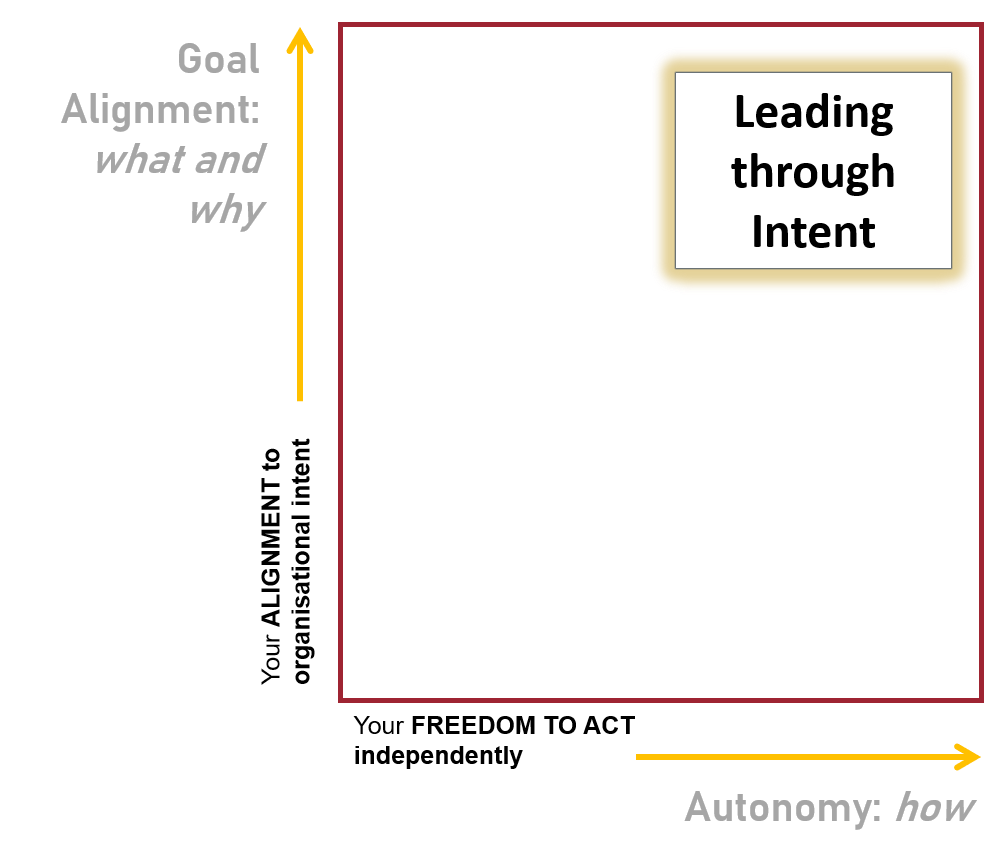Many of today’s organizations are no longer fit for purpose
Leading through Intent is a proven operating model that enables organizations to work effectively in rapidly changing and complex environments.
Many large and successful companies developed their organizations on models rooted in the industrial revolution. These models attempted to grapple with the challenges posed by increasing complexity, globalization, technology, and the pace of change.
But they, and the people who lead them, have reached, or soon will reach, the natural limits of their ability to cope because the current business environment is more unpredictable, complex, and fast-moving than ever before. And they find it harder to adapt as the environment around them continues to change faster than they can evolve.
The idea
A book written in 2011 by Dr Stephen Bungay, The Art of Action, described a leadership operating model that enables organizations to work effectively in rapidly changing and complex environments. Since 2006 we’ve helped organizations in a range of business sectors to adopt approaches based on the Art of Action principles. We call this approach Leading through Intent.

What is Leading through Intent?
Leading through Intent is not a theory, but a set of beliefs, practices, and behaviors. It is not a new idea. It emerged in various organizations, often military, at times when the environment in which they operated was fast-moving and uncertain, and the operating systems they had available were unable to keep pace, creating friction, slowing things down, and rendering tight control self-defeating or obsolete.
Many of you will recognize that environment as the one we work in today. If you disagree, what we have to offer may not be for you!
Large organizations that make things happen effectively in complex, fast-moving, and unpredictable environments need both high alignment and high autonomy.
Leading through Intent describes a way of thinking and acting, combining behavioral and procedural components to mitigate the effects of organizational friction. Organizations embedding these principles are better able to make things happen effectively in complex, dynamic, and unpredictable environments where they and their partners need high degrees of strategic alignment balanced with high degrees of operational autonomy.
The Alignment v Autonomy Paradigm
The architects of Leading through Intent realized that centralized command and control was not the answer. It suffocates organizational agility and tempo.

They figured out that the more alignment you have, the more autonomy you can grant. It starts at the level of strategy where you create a systemic understanding of what you want to achieve and why.
The basic principles of Leading through Intent
1. Give direction based on a clear intent
Deciding what really matters is about clarity of intent (the intended outcome and purpose behind it). It places strategic goals in the context of the prevailing situation and ensures unity of effort.
A clear intent ensures that most of the activity, focus, and appropriate resources, are focused on the most important outcomes, and everyone sees the big picture and can see how their contribution ties into it.
2. Use structured briefing and backbriefing to enable alignment
Communicate clearly and often what success looks like and why it’s important. Keep things simple using a common, structured, and rigorous technique. Our process for translating strategy relies on a process of analysis using five questions (we refer to this as 5MAP®).
5MAP® helps teams and individuals to decide ‘how’ they will realize intent and brief their leaders on what to expect. This ensures that plans remain aligned and that all contributions are purposeful and coherent.
3. Empower execution by letting your people find the path
Future outcomes cannot be predicted with certainty, so encourage employees to be adaptable, exercising initiative and self-discipline to adapt their approach as the situation changes.
Leaders establish broad, but clear boundaries that create mutual confidence and then actively support people to make full use of the freedom they have been given. People are more likely to decide how to act (or not) in response to a changing situation when they are confident that well-intentioned actions, even if they fail, will be supported.
How Leading through Intent works in practice
The application requires leaders to do tangible, practical things to apply the principles of Leading through Intent. We’ve identified six practices that can be codified and taught to leaders participating in a Leading through Intent development package. These practices can be rehearsed in practical application to provide learning opportunities and to build intent-based leadership skills and confidence.
- Practice 1. Being clear about the context and what really matters.
- Practice 2. Formulating intent based on outcomes, not activity.
- Practice 3. Translating intent into action and briefing to create shared understanding,
- Practice 4. Facilitating alignment by backbriefing.
- Practice 5. Giving people the freedom to act.
- Practice 6. Supporting people to act and make decisions.
Typical Leading through Intent Solutions
Our solutions are always based on a thorough understanding of your needs. We glean as much insight as possible from a literature review and structured interviews before agreeing on a detailed work programme. Whilst we will always implement in line with our core beliefs and principles, every implementation will be tailored to your specific organizational needs and culture.
Developing Direction
A focus on developing a strategy that is flexible enough to adapt in the flow of work, with clear direction, as opposed to the more prescriptive approach adopted in traditional or ‘deliberate’ strategy.
Strategy to Action
Our strategy-to-action programme supports organizations to cascade strategy to critical business teams and translate it in a structured and consistent way to ensure alignment. It uses 5MAP to embed Leading through Intent practices at the operational level where decisions must be made about execution.
Leadership through Intent Behaviors
Any organization seeking to adopt an agile operating model will need to embed changes in leader behavior. We’ve noted that many leaders respond to uncertainty in similar ways that indicate they are not well-equipped to deal with today’s leadership challenges. Sometimes these behaviors result from formal training, though more often than not they reflect common and embedded organizational practice. We need new ‘plays’ more appropriate to today’s uncertain and dynamic business environment. Leading through Intent is focused on changing leader behavior to implement these new plays.
Leading through Intent Academy
Our LTI academy is a new blended learning programme intended for organizations seeking to embed Leading through Intent in their core leadership curriculum. It combines face-to-face and virtual learning with coaching and self-paced assignments over a three to six-month period. The learning journey is supported by the award-winning Promote learning platform and may be supplemented with individual coaching for participants.
Benefits of Leading through Intent
The Leading through Intent concept, with its associated techniques and behaviors, has been implemented with success in a wide range of sectors including leading businesses in the pharmaceutical, biotechnology, engineering, publishing, technology, business services, and one Formula One motor-racing team.
When we implement Leading through Intent in business organizations the results typically reflect the companies’ underlying cultural phenotype and the ability of their leadership to adapt to the new operating model. When it’s working well, we observe many of these features:
- A clear overall intent provides a unifying purpose for people;
- There is better alignment between what people are doing and organizational priorities;
- Teams focus on getting things done and developing strong lateral connections with other teams;
- Leadership and decision-making are distributed throughout the organization.
- People tend to use their initiative and adapt, in line with overall intent, as the situation changes.
What is Leading through Intent?
In this short video, Stephen Bungay provides a short introduction to Leading through Intent and its core principles.
He explains Leading through Intent is about how to execute strategy in a fast-moving, complex, and volatile environment.
The three basic building blocks are:
- Formulate and communicate a clear intent.
- Define the playing field.
- Support people to use it effectively.